Content Marketing for Startups: Low-Budget Strategy To Scale

Content marketing is an extremely proficient tool that a startup can use to grow its business operations. It can offer a lot to startups, whether it’s lead generation, user engagement, or creating a sturdy ground to stay on in your industry.
In this article, we will zoom in on the essential steps of content marketing for startups. We will cover everything from creating a content strategy to distributing your content to measuring your results.
By the end of this article, we sincerely hope you will have a clear understanding of how to use content marketing, how to organize it and use it to achieve your startup's goals.
Let’s get to it, but before the steps you need to take, it’s worth defining content marketing along with documenting the benefits it can bring.
Content marketing: definition and benefits for your startup
High-quality content marketing for startups is, first of all, a strategic marketing approach. It implies creating and distributing content that focuses on value and relevance to attract and engage a specific target audience.
Unlike traditional advertising, content marketing’s primary focus is to generate informative content for users. It may entertain or educate them or even solve pending issues. The primary goal is not to promote a product or service explicitly but rather to build trustworthy relationships with users.
At the heart of content marketing lies storytelling. Whether it's through blog posts, videos, infographics, podcasts, or social media content, startups can use storytelling to connect with their audience on an emotional level, ultimately leading to increased brand loyalty and customer retention.
The benefits of content marketing for startups
Content marketing is undeniably beneficial in a lot of ways. Startups-wise, it still can bring a lot to the table. Moreover, especially content marketing tends to be the most popular choice among fast-growing businesses. So, why is content marketing important for startups?
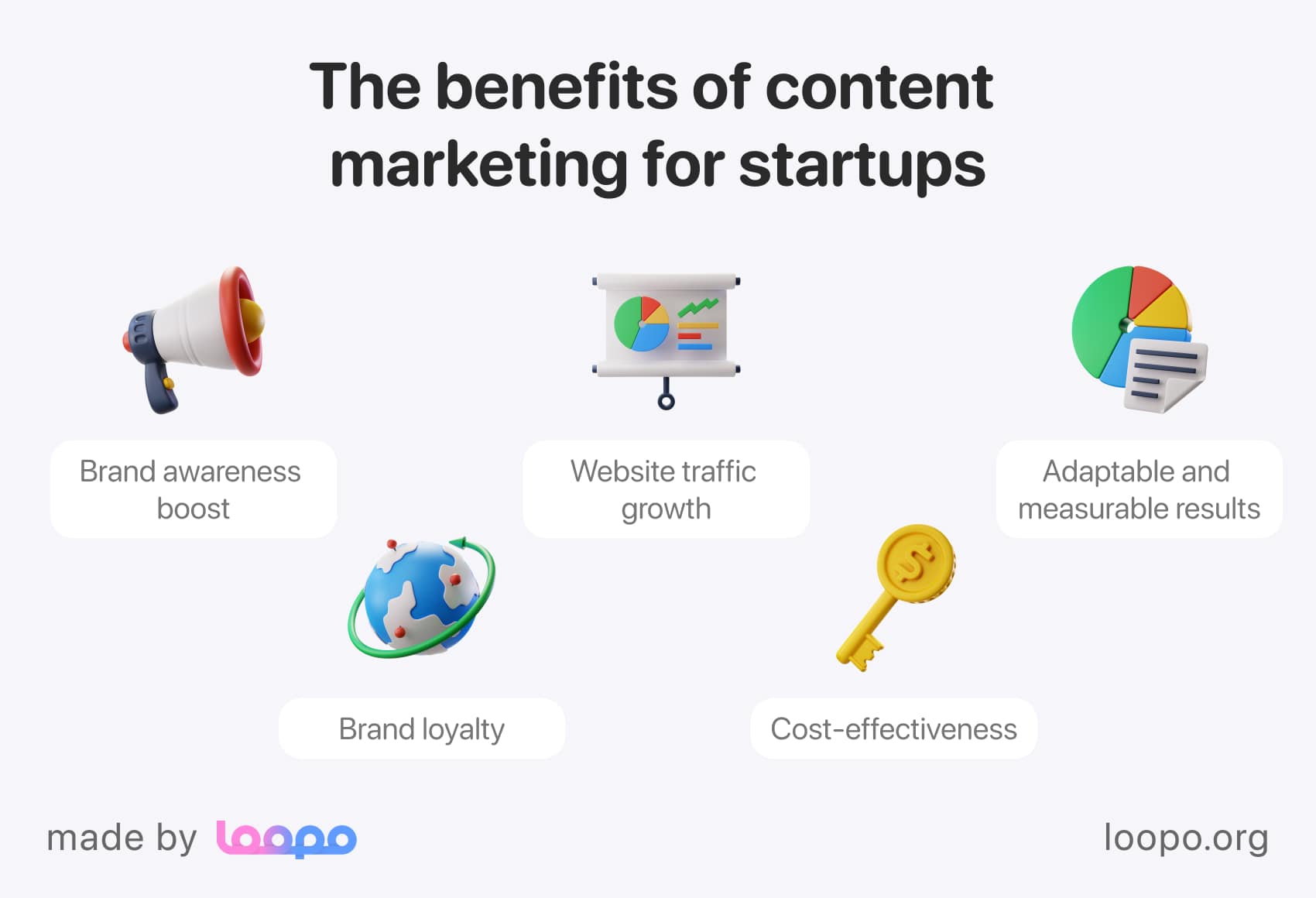
Brand awareness boost
Startups are eager to find recognition. So, content marketing does this job perfectly fine as it advocates consistent publishing and emphasizes valuable content. Valuable content is more likely to be shared, expanding your reach even further through word-of-mouth marketing.
Website traffic growth
When your content aligns with your users’ interests and pain points, you can expect a rising tide of visitors, increasing your overall visibility online. The traffic content marketing is aiming to acquire increases the chances of lead generation and improves your website's popularity in search results, making it more discoverable.
Brand loyalty
When your content consistently delivers value to your audience, it fosters a sense of loyalty and connection with your brand. Engaging and personalized content can make customers feel understood and appreciated, leading to long-term relationships and repeat business.
Cost-effectiveness
Compared to traditional advertising, high-quality content marketing for startups is an extremely cost-effective alternative. It still requires solid management skills and time/effort investment but typically costs less than running large-scale ad campaigns.
Adaptable and measurable results
A huge benefit is its adaptability. It is flexible enough to allow startups to experiment with content formats and observe their audience’s preferences. Additionally, content marketing's success can be measured with analytics tools. With their help, you can track content’s performance and, based on it, make mindful business decisions.
7 Major Steps To Create a Content Marketing Strategy
A well-defined content marketing strategy is the cornerstone of success for startups aiming to harness the power of content to grow their brand. Normally, a content marketing strategy is a big and detailed plan. It must encompass numerous aspects, align with your startup's goals, and resonate with your target audience.
For now, we will outline a comprehensive guide to crafting an effective content marketing strategy and divide it into smaller steps. Later, you will be able to refine each and decide which one requires more focus and improvements.
Step 1: Define Your Goals and Objectives
Every successful strategy starts with clear and specific goals. When you put emphasis on content, identify the results you want to see with your content. In this matter, you can ask yourself:
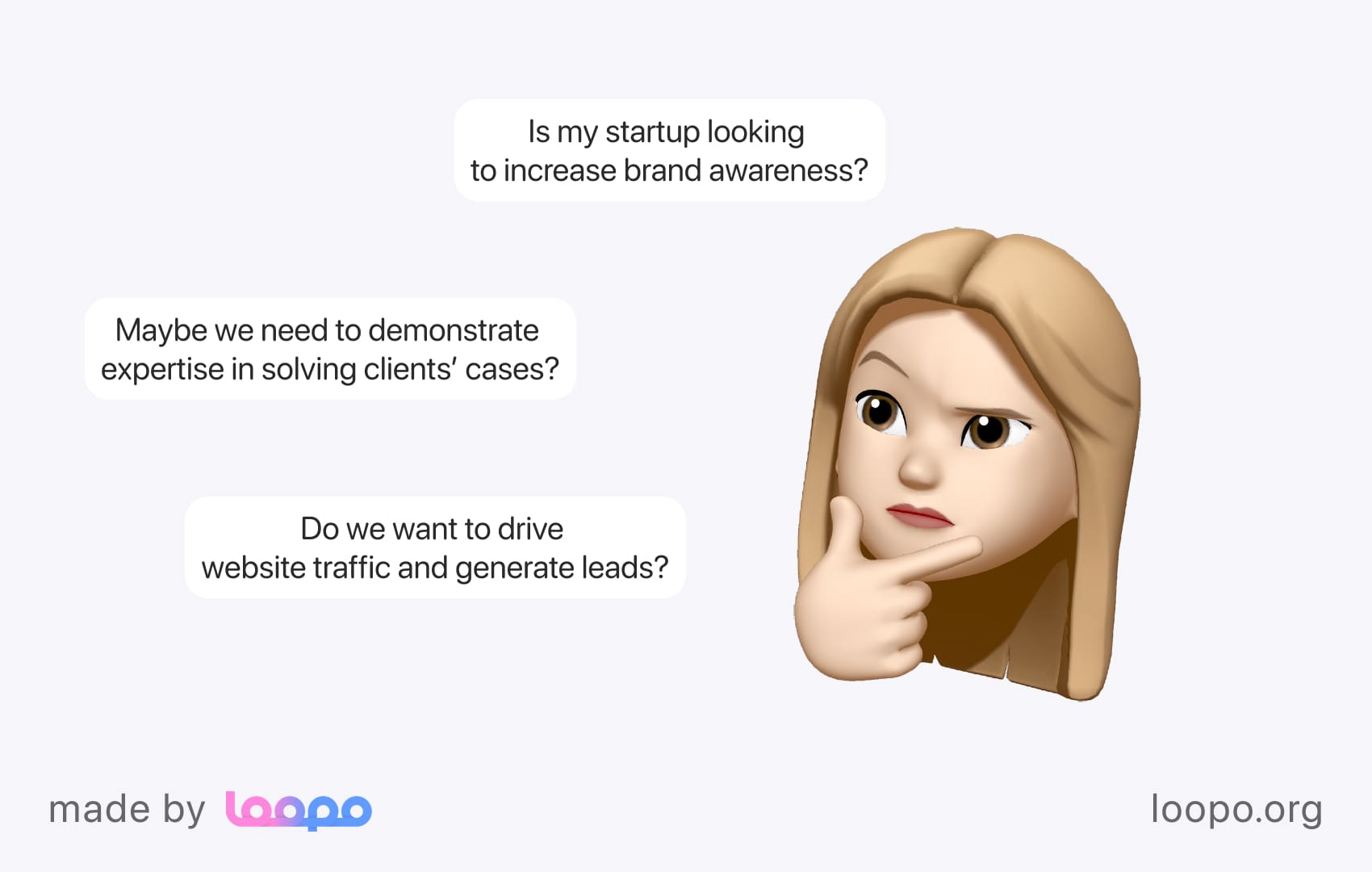
- Is my startup looking to increase brand awareness?
- Or do we want to drive website traffic and generate leads?
- Or maybe we need to demonstrate expertise in solving clients’ cases?
Defining particular goals you want to achieve by the end of the marketing campaign can set a tone for the whole strategy. Setting measurable goals will help you analyze the progress. Moreover, you can edit the strategy and adjust some variables to improve overall results.
Step 2: Know Your Target Audience
After you set goals for the strategy, what else do you need to know? Right, who to attract with this strategy? Seeing through your users is pivotal as it directly affects how you will be creating content. To discover who your average consumer is, you can take several steps.
Develop detailed buyer personas
They are prototypes of your average users. Normal buyer persona encompasses demographics, interests, pain points, and behavior patterns of people. This knowledge will guide your content creation process and ensure that your messaging speaks directly to your audience's needs and preferences. Here’s a short table outlining the example of two buyer personas for a potential startup you are planning to create.
| Aspect | Buyer persona 1 | Buyer persona 2 |
| Background | Aspiring sustainable fashion entrepreneur | Digital marketing professional |
| Demographics | Age: 25 | Age: 30 |
| Gender: female | Gender: female | |
| Location: urban, eco-conscious city | Location: urban tech hub | |
| Education: self-educated, online courses | Education: marketing degree | |
| Income: limited budget, bootstrap approach | Income: mid-tier professional | |
| Goals | Launch eco-friendly clothing line | Stay current with digital marketing trends |
| Source sustainable materials | Enhance client campaign efficiency | |
| Build engaged community | Prove agency's value to clients | |
| Challenges | Limited funds for production/marketing | Limited time for multiple projects |
| Finding reliable sustainable suppliers | Tracking analytics across platforms | |
| Creating unique brand identity | Adapting to evolving algorithms | |
| Psychographics | Creative, determined, environmentally conscious | Curious, driven, analytical, adventurous |
| Values | Sustainability, authenticity, community | Professional growth, client value, innovation |
| Behavior | Extensive online sustainable fashion research | Attends webinars, engages on LinkedIn |
| Engages with sustainable lifestyle content | Active in digital marketing communities | |
| Attends local eco-friendly events | Relies on productivity tools | |
| Preferred channels | Social Media: Instagram, Pinterest | Social Media: LinkedIn, Twitter |
| Online communities: sustainable fashion forums | Online communities: digital marketing forums | |
| Blogs/vlogs: sustainable fashion influencers | Industry blogs: reputable sources | |
| Local events: eco-friendly markets | Webinars/conferences: online and in-person events | |
| How startup can help | Connect with eco-friendly suppliers | Provide comprehensive campaign dashboard |
| Budget-friendly marketing strategies | Real-time insights, trend-based suggestions | |
| Authentic brand image support | Tailored recommendations |
Do research, polls, and surveys
Once you have a certain number of users, you can suggest they participate in polls and research you conduct. You can ask general questions which users won’t have a problem with. Here’s a short outline of the most common questions.
- Demographics;
- Gender;
- Age;
- Education;
- Occupation, or domain;
- Professional background etc.
Research the market
When you enter a market, it’s pivotal for a startup to be up-to-date and suit the current niche. Thus, to improve your chances to become a successful startup, make sure you analyze the data about the market and know what end users need. There’s a big chance that the market you’re entering already has something similar to what your startup is going to offer. Hence, it is important for you to understand the current market situation in order to react faster to changes and be able to change the product to suit the current needs.
Step 3: Conduct a Content Audit
Revising your existing and future content is a wise decision to always improve and grow. However, there are several sub-points in conducting content audits.
Evaluating existing content
A content audit involves reviewing all the content assets your startup has produced, including blog posts, videos, infographics, podcasts, ebooks, and more. The main objective should be a careful review of your publications. Thus, asking yourself is a good technique to evaluate the content.
- Ask about quality. Is it up-to-date, readable, and unique enough? Is the content well-structured and easy to understand?
- Ask about relevance. Does the content still do the job of informing people? Does it fulfil audience interests and search queries? Do we need to update the materials to meet the needs of today’s market?
- Ask about performance. Does the content we produce meet the desirable number of page views, time on page, social shares, comments, and conversion rates?
Last but not least, the evaluation process should directly align with the goals you set during the first step. Simply put, all parts of the strategy should work like clockwork, complementing each other.
Identifying gaps and opportunities
After asking yourself and a thorough review, you might identify gaps or opportunities that your startup can capitalize on.
- Topic gaps. There might be several topics and trends relevant to your startup which you missed and didn’t cover in your publications. Identifying these gaps can help you create content that is actually helpful to users and fulfills their current interests.
- Format diversity. There might also appear several formats you missed, or they simply became popular later. If you've primarily focused on blog posts, consider whether incorporating videos, infographics, or interactive content could enhance your strategy. For example, you could start doing TikToks or podcasts if they became significantly popular after you established a content plan.
- Keyword optimization. Check whether your existing content is optimized for relevant keywords. If not, there might be opportunities to update and optimize older content to improve its search engine visibility. This not only includes keywords but also updating URLs, adding new links, optimizing images, etc.
Content consolidation and repurposing
During the content audit, you might find that some content assets cover similar topics or could be combined into more comprehensive resources. Consolidating content can improve user experience and make it easier for your audience to find the information they need.
For example, you might have huge blog articles that you can turn into lead magnets or e-books. Alternatively, you may have long videos on YouTube. You can divide them into short videos from existing ones and publish them on Instagram Reels, Stories, or TikTok.
Step 4: Choose content types and channels
Unfortunately, it would be challenging to manage all content types and all existing channels. Thus, you need to choose a few of both that are the most natural to your startup’s nature. Nonetheless, let’s figure out what you can choose from.
Content types
Different content formats resonate with different audiences. Choosing the right content types for your startup involves considering both your audience's preferences and your brand's strengths. As of today, you have chosen a lot of options.

- Blog posts. Written articles are versatile and can cover a wide range of topics. They're great for sharing insights, guides, news, and more.
- Videos. They are engaging and can convey complex information in an easy-going and understandable form. Consider tutorials, product demos, interviews, and storytelling videos.
- Infographics. People tend to share visual representations of data as they are easy to understand and memorize at a glance. Infographics can simplify many complex concepts providing more information about difficult aspects of your startup’s operations or products.
- Podcasts. If your target audience prefers audio content, podcasts are a great option. They allow for in-depth discussions, interviews, and thought leadership content.
- Ebooks and whitepapers. These longer-form resources are ideal for providing in-depth information or comprehensive guides on specific topics.
- Social media content. With platforms like Instagram, Facebook, Twitter, and LinkedIn content marketing for startups offers a myriad of opportunities for short-form content, visuals, and engagement with your audience.
Distribution channels
Choosing the right distribution channels is essential to ensure your content reaches your target audience where they're most active. The channels you choose directly depend on the content type you are planning to choose. However, here are all options to consider.
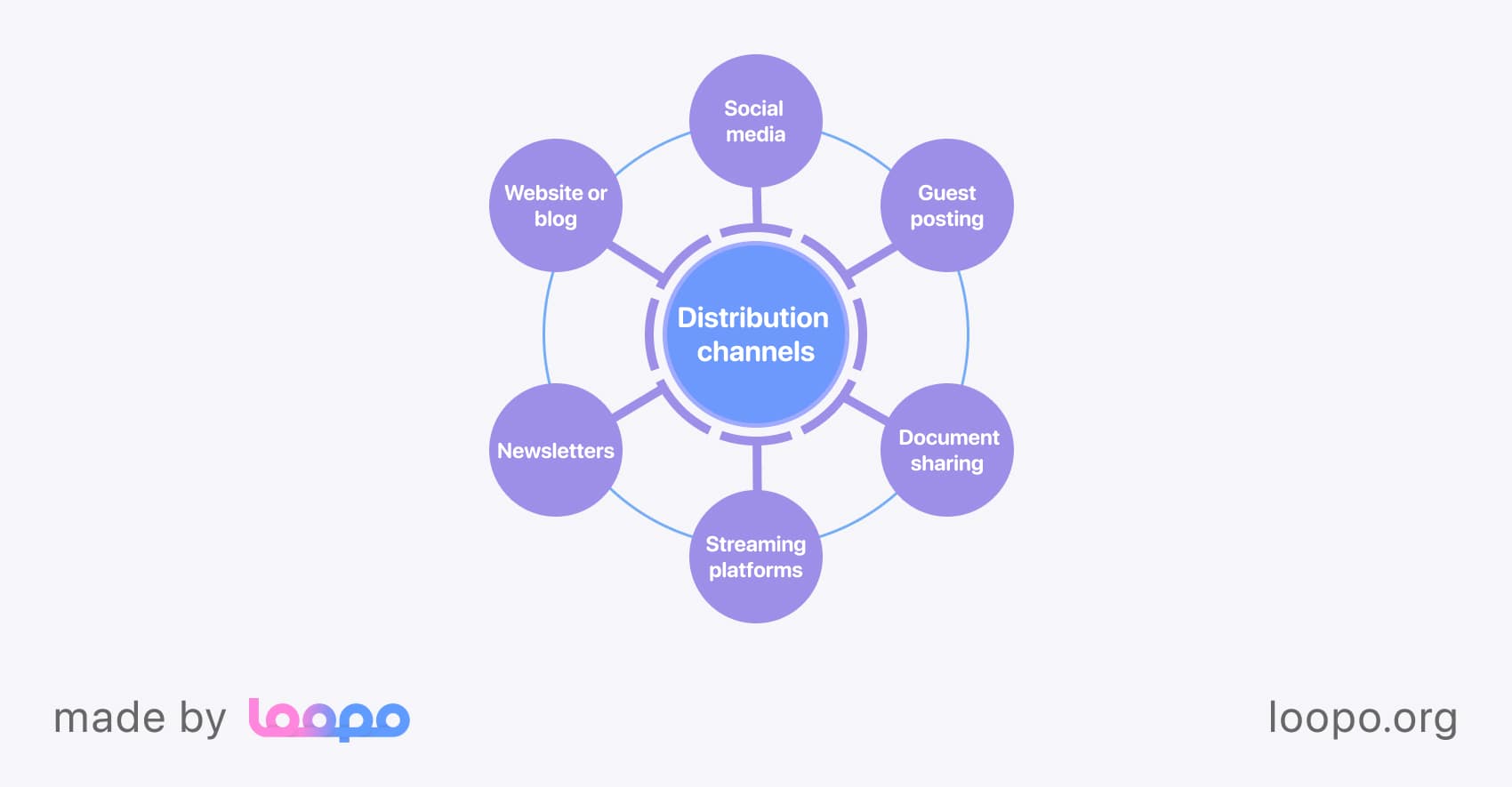
- Website or blog. Your own website is your content's home base. Publish your articles, lead magnets, and e-books on your blog or resources section, making it easily accessible to visitors.
- Social media. There are lots of them, and you should choose ones that are relevant to your audience. Each platform has its own perks. For instance, LinkedIn is ideal for professional networking, while with Dribbble, you can showcase your design works.
- Newsletters. Send your content to your email subscribers. Email newsletters let your audience stay up-to-date with your latest publications, sales, or updates.
- Podcast platforms. If you're producing podcasts, distribute them on podcast platforms like Spotify or Apple Podcasts. Besides, you can even publish them on YouTube or stream them live.
- YouTube and other streaming platforms. If you're creating video content, platforms like YouTube can help you expand your presence there.
- Document sharing platforms. If you choose to share comprehensive materials like presentations, ebooks, and whitepapers, you can try using SlideShare.
- Guest posting. Collaboration is also a great tool to reach a wider audience and establish your authority. In this regard, you can submit your text materials to websites that publish articles in similar niches.
Tailoring content to channels
It is nice to remember that each distribution channel has its own unique requirements and audience behaviors. Do not simply create content and pretend it fits everywhere. Instead, consider dominant formats on the platforms you chose, along with what the audience expects to see there. For example, a video meant for YouTube might need captions and engaging visuals, while a LinkedIn post might require a professional tone and statistics or citations.
Step 5: Research Keywords and Topics
If you are not familiar with SEO, then it’s the right time to meet it. If you are, then emphasize its presence in your content marketing strategy.
Search Engine Optimization is a website or online content optimization process. SEO toolkit can significantly boost content’s visibility and ranking on Google, Bing, or any other search engine. Search engine optimization always aims at making your page more discoverable and clickable on search engines. Simply put, the better SEO specialists do their job, the higher in search results your pages will be when users search certain keywords. This increased visibility can lead to more organic (unpaid) traffic to your website, ultimately benefiting your online presence and business.
So, how come SEO is a vital part of a content marketing strategy for startups?
Topic research
It is also a vital aspect of SEO. While keywords are crucial, topics provide a broader context for your content. They help you create reasonable content for your audience, addressing its concerns, challenges, and questions. To conduct effective topic research, you can do a lot of things. Moreover, they were partially defined in a second step, so it should be much easier to do at this point.
The audience’s needs should be your primary focus, and you need to adjust your content to fit their interests. Consider their most frequent problems and search prompts. Alternatively, you can use online forums, social media, and surveys to gather insights into their pain points and interests. In this regard, you can turn to the most popular platforms like Reddit, Discord, Quora, etc.
Keyword research
At the core of this process lies the analysis of specific word combinations that people use when searching for information. Hence, SEO specialists take advantage of them, incorporating those words into all textual content. Consequently, they boost the chances of your content appearing on SERPs (search engine results pages).
To dive deeper into SEO intricacies, use specialized tools. Tools like SEMrush, Surferseo, or Ahrefs can be of utmost help in this regard. With their functionality, you can discover relevant keywords. Moreover, you can analyze their search volume and how much they are popular compared to others.
Balancing SEO and audience needs
Finding a balance between optimizing for search engines and meeting your audience's needs is an important part of SEO and content marketing as a whole. While using keywords helps with SEO, you must still steer the content in a way to provides value to your readers.
In other words, it must feel natural and not be oversaturated with keywords and links. Aim to create content naturally incorporating keywords while delivering valuable insights, solutions, or entertainment.
Step 6: Promote and distribute
Creating amazing content is only half the battle. Getting it in front of the right eye is equally important. Effective promotion and distribution increase the visibility and reach of your content, and luckily, there are a lot of ways to do so.
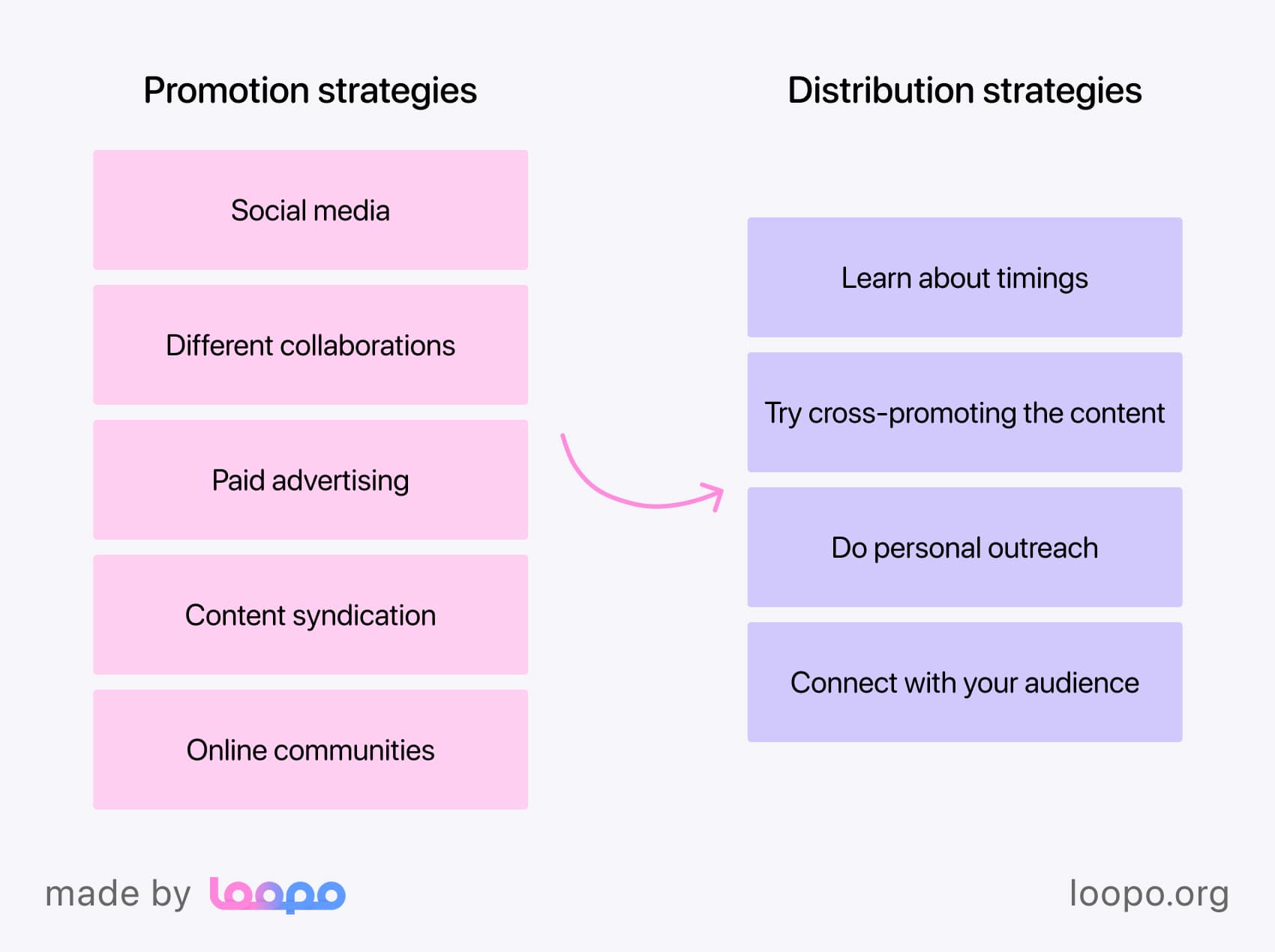
Promotion strategies
- Social media. It’s no surprise that social media are huge content boosters. Each platform provides many tools and helpers to promote content. With LinkedIn, you can use relevant hashtags, while TikTok, and Instagram Reels rely more on organic promotion methods.
- Different collaborations. You can partner with influencers, media, or even other startups to share your content. You can benefit from their popularity to reach a wider audience and negate trust issues.
- Paid advertising. With paid social media advertising, Google Ads, or other online advertising platforms, you can boost your content to the top, yet it can be quite pricey.
- Content syndication. Syndicating your materials on platforms like Medium or LinkedIn Articles can help you diversify your agenda and reach new audiences. However, ensure that the canonical version resides on your own website so interested people can refer to it.
- Online communities. Platforms like Quora, Reddit, or even Discord servers allow you to share your content with your potential audience. Make sure you follow relevant online forums, join groups, and presented yourself in communities where your target audience hangs out.
Distribution strategies
Unlike promotion strategies, distribution techniques fluctuate and may change a lot. However, there are a few solid pieces of advice you can inherit.
Learn about timings
In different channels, posting timings differ and are based on the times when the majority of users are most active. This might require some experimentation and analysis of engagement metrics.
Try cross-promoting the content
For example, showcasing your newest blog publications in Instagram Stories can be helpful to maximize visibility and notify those who missed it.
Do personal outreach
In your publications, you will often refer to someone’s words and publications. Hence, it would be a great idea to reach out to individuals or organizations mentioned in your content and ask them to share it with their networks.
Connect with your audience
Respond to people’s activity. You can find time to reply to comments, address concerns or answer questions. Engagement encourages more interactions and can lead to increased sharing.
Step 7: Measure and Refine
The last step, but no less important, is regular performance measurement. In fact, after all the steps you take, it is essential to understand what's working, what's not, and how you can improve. It helps you align your efforts with your startup's goals, maximize the impact of your content, and adapt to changes.
Key performance indicators (KPIs)
Different content goals require different KPIs to be tracked. The most common indicators are as follows.
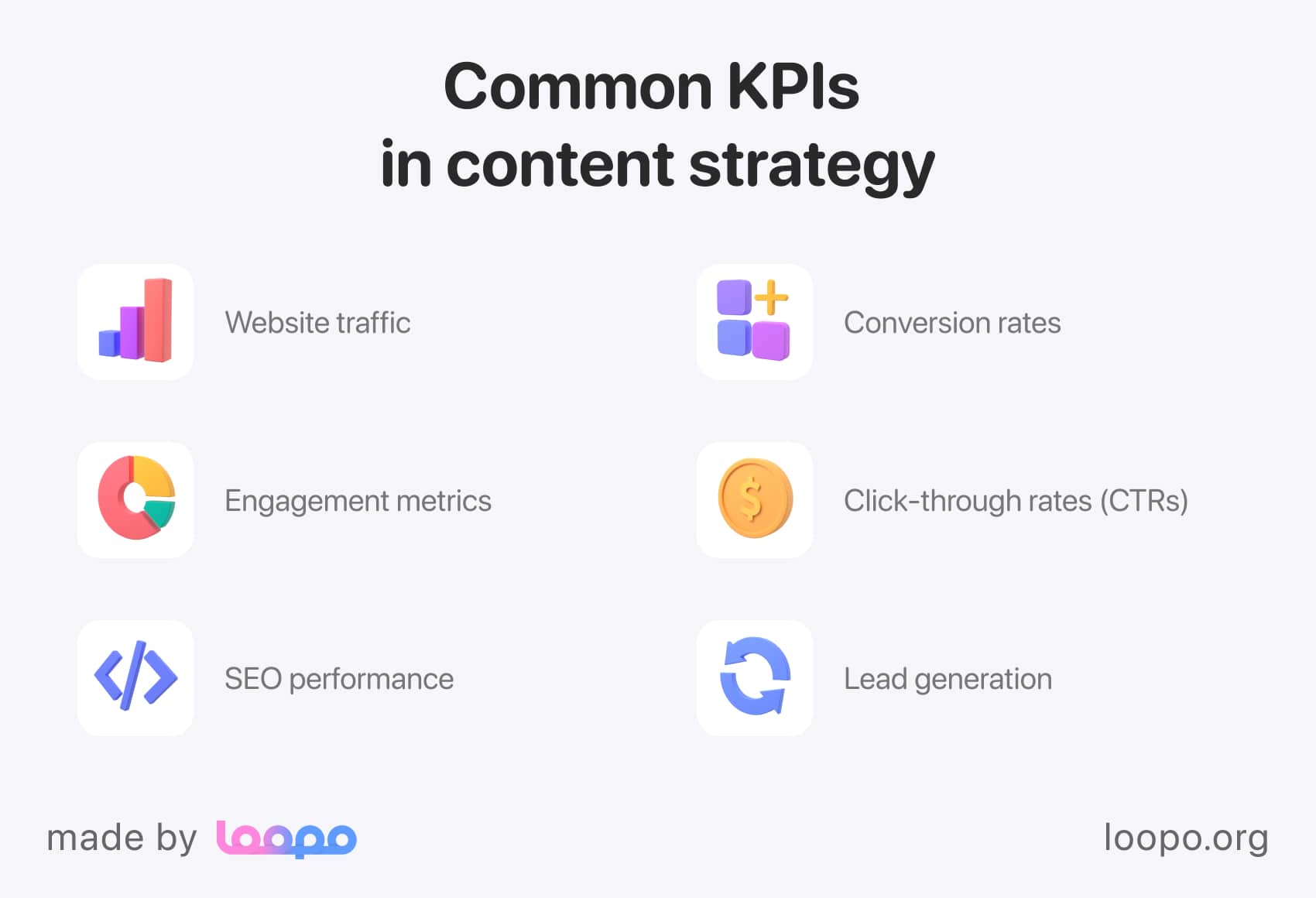
- Website traffic. It helps you monitor the number of visitors to your website and specific pages where your content resides.
- Engagement metrics. Track metrics like social shares, likes, comments, and time spent on the page to gauge how well your content resonates with your audience.
- Conversion rates. They allow you to measure visitor count. For example, you can observe how many users signed up for emails or the number of purchases they have made.
- Click-through rates (CTRs). If you're using email marketing or ads, track the CTR to see how effective your content is at driving clicks.
- SEO performance. Monitor your content's ranking on search engine results pages and the organic search traffic it generates.
- Lead generation. If lead generation is a goal, track the number of leads generated through your content efforts.
Analytics tools
To measure everything we mentioned above, you can opt to use many different tools.
Among the most popular is Google Analytics. It offers a wealth of data about website traffic, user behavior, and conversions. If social media is your primary concern and channel, top platforms like Meta, Twitter, or LinkedIn provide lots of insights and engagement metrics.
If you aim at email marketing, platforms you might want to use also provide a lot in terms of analytics. For instance, Mailchimp, the most prominent and popular choice, provides everything you may need to track the performance of your email marketing campaign.
Lastly, there are many different external analytics systems. You can easily integrate or connect them to your website and analyze their output. Speaking of examples, Amplitude and Microsoft Power BI would be great choices.
Loopo's flow in content marketing
As mentioned, managing content marketing can be very cumbersome. Basically, it is often very complex because of the number of channels you use. Not to mention the efforts you need to put into research, polls, audits, and so on. Luckily for you, today’s startups can greatly help in this regard. Today’s digital world has a lot to offer in terms of management, planning, and delegating such complex processes.
Loopo, our task management tool, can be of utmost help in delegating all those processes and simplifying the routine. With the functionality it provides, it is suitable for IT companies, startups, and many different kinds of ventures. Here’s what it has to offer.

Content calendar
In content marketing, planning is the ultimate king. Without it, the entire strategy can go wrong in days and take weeks to fix. With Loopo though, you can forget about those challenges. In Loopo, we came up with the idea to improve the content planning routine with a calendar. Now, it can help you schedule publication for a year ahead. Needless to mention you can also move them, and categorize them by channels or other variables.
In the calendar, each task instance can be created with only a few clicks. Here’s an outline.
Click a button to create a task → Give it a name and choose a channel → Choose a publication date → Add optional tags → Add necessary viewers or editors → You’re set!
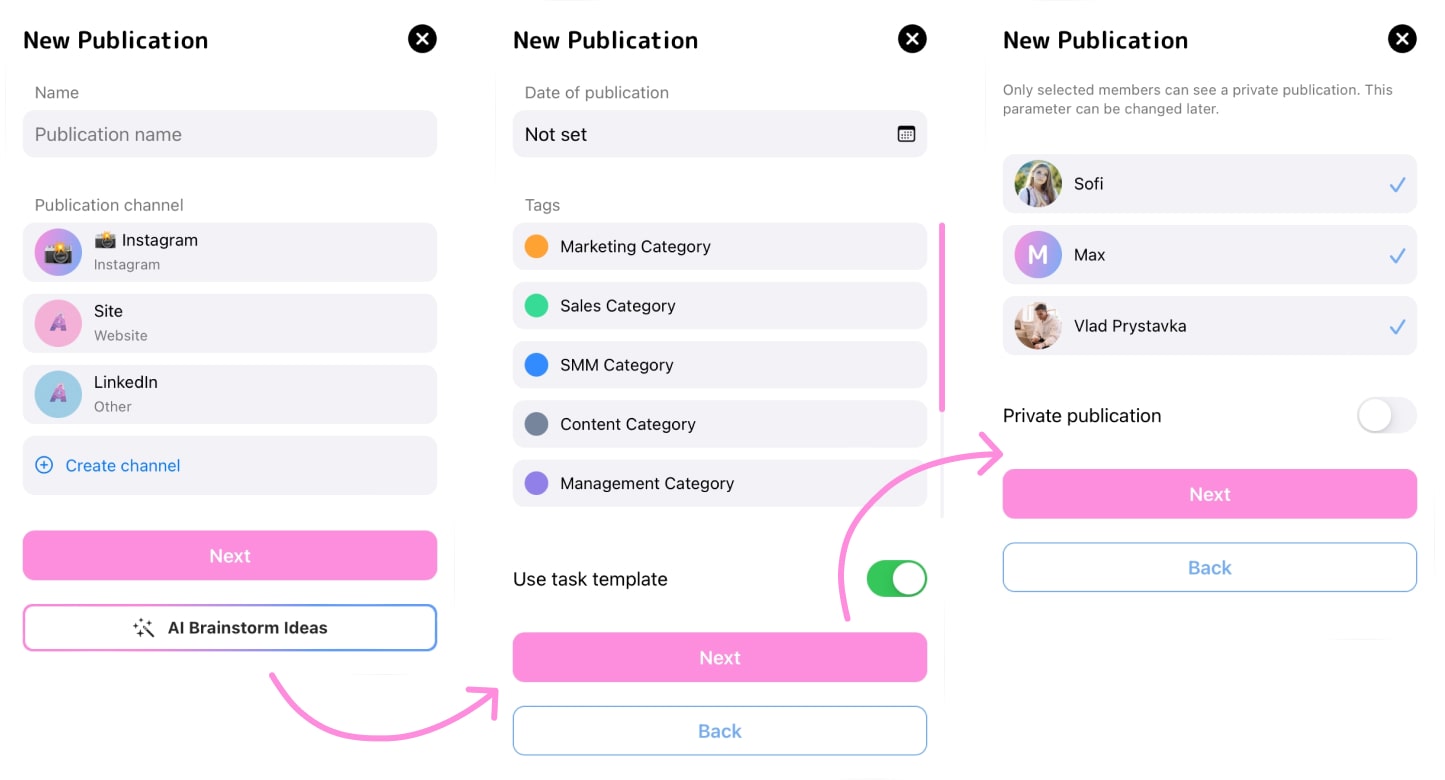
Each publication instance can be accessed with a click. In the new tab, you are provided with various text editing tools to create, edit and improve your content on the go.
Additionally, you can change the details you set when creating the publication. Thus, feel free to postpone the publication deadline, adjust tags, and add new members!
Lastly, to make you never leave the app, we also added attachments. You can add all common types of files and media.
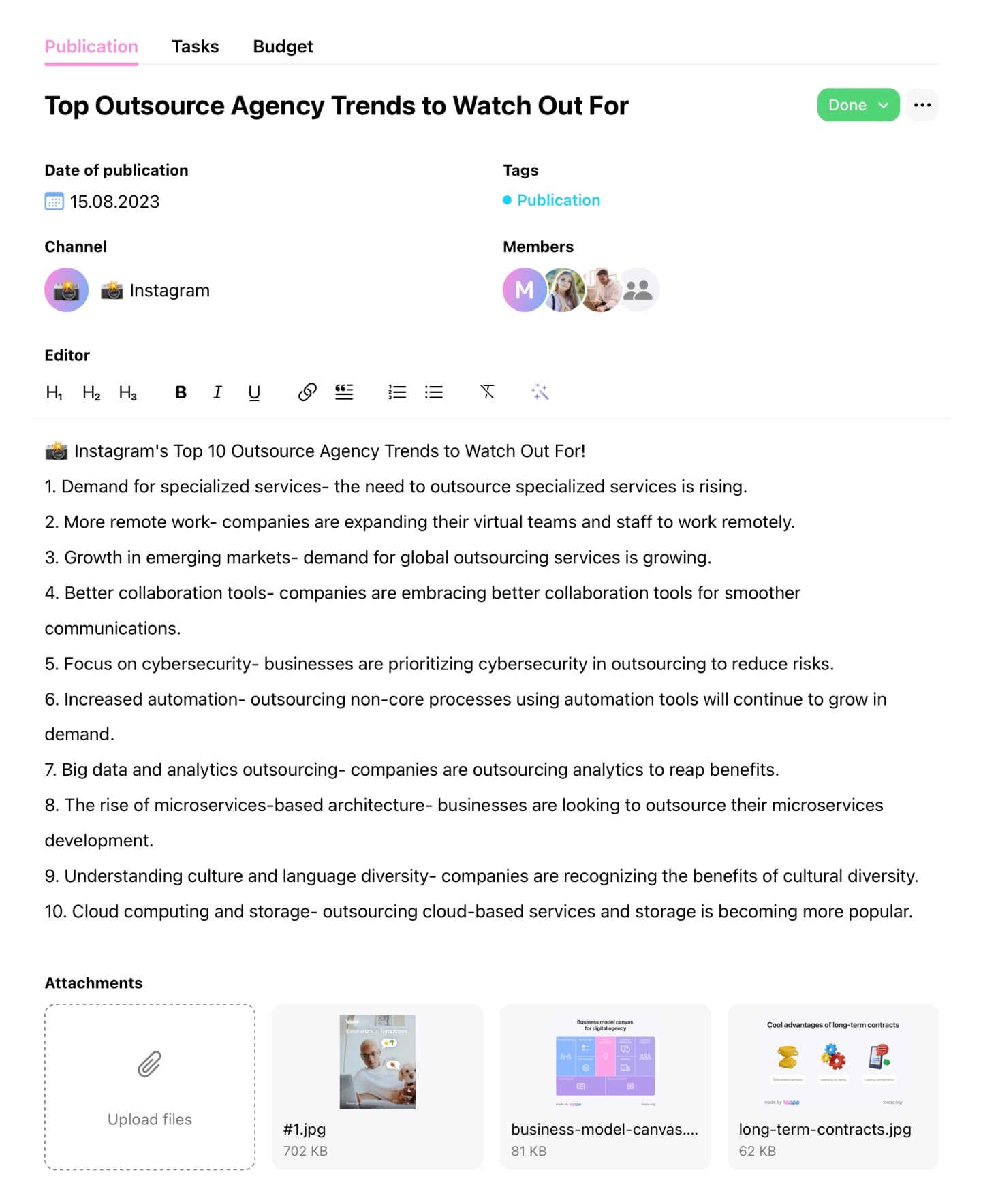
AI integration
As you may have noticed, among the text editing functionality, there’s a magic wand. It represents the AI integration that can truly do magic.
With Loopo AI, you can generate titles, social media publications, or simply ask for ideas during unproductive days. In addition, there are prompts, to simplify the job.
What else is there to say? As a task management tool, Loopo doesn’t offer a ton of functions. Instead, it offers the essentials everyone needs in content marketing management. Have you signed up yet? Try it now!
Content marketing for startups: tips and tricks
Content marketing is a volatile environment where trends change regularly. Hence, prominent marketers always invent something captivating to keep engaging the audience even in the field with many competitors. Let’s list a few content marketing tips for startups that might fit yours.
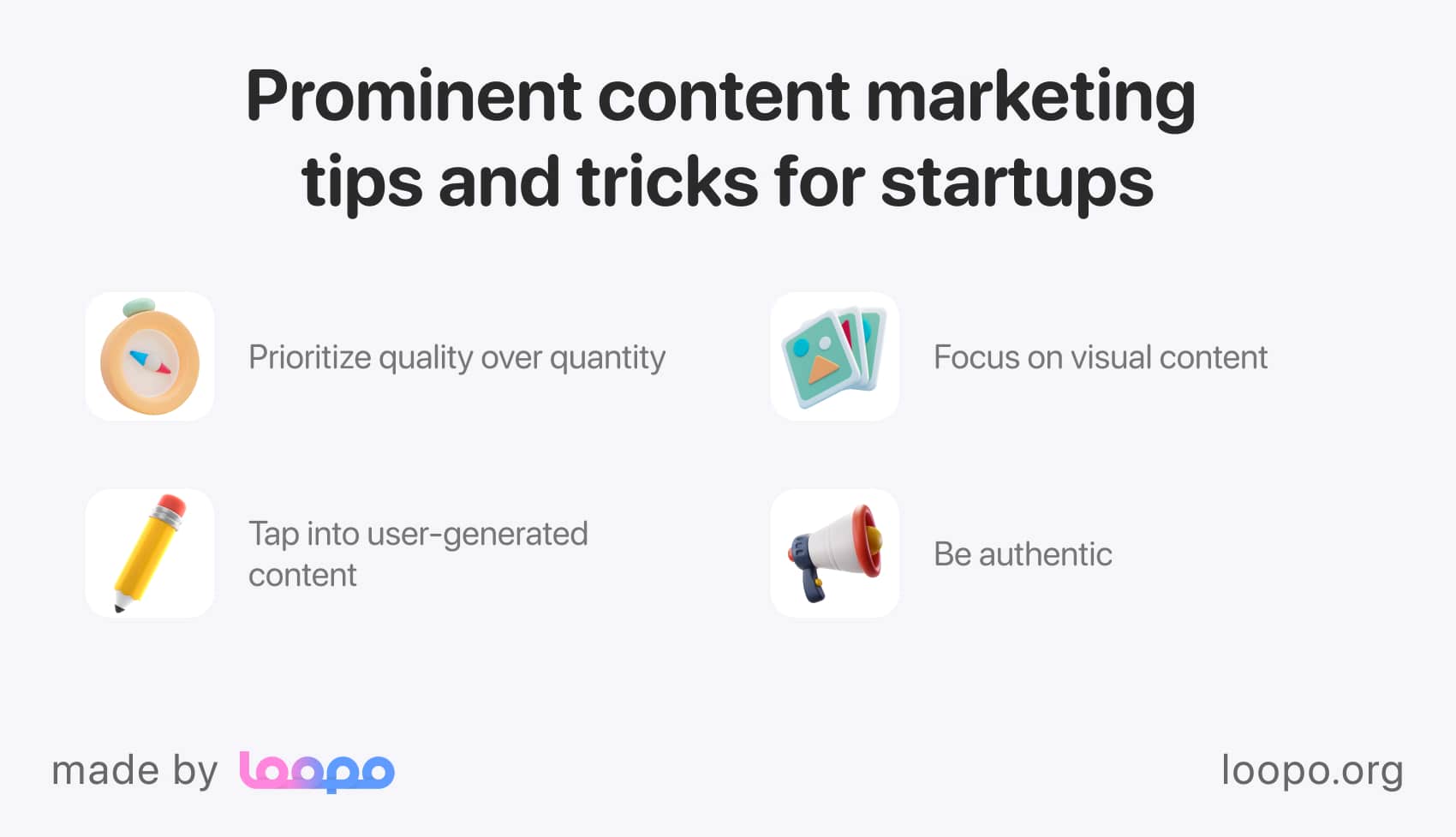
Prioritize quality over quantity
Quality should always be the focus. Produce well-researched content that can comprehensively cover all potential needs of your users. High-quality content earns trust and loyalty from your audience. On the other hand, too much content can produce a lot of noise, delivering very limited and poorly researched information.
Tap into user-generated content
Fostering the idea that users can generate content and be heard by other users can greatly boost your startup’s success. User-generated content can help you build a sense of community which is extremely beneficial to have for small startups.
Focus on visual content
As Hubspot’s research shows, people remember only 10% of the information they heard over a span of 3 days. On the contrary, it the info is backed with a relevant visual content, the retention rate can easily grow up to 65%. Thus, marketers became way more interested in creating visuals. Here’s a clear example showing percentages of publications that contains visuals.
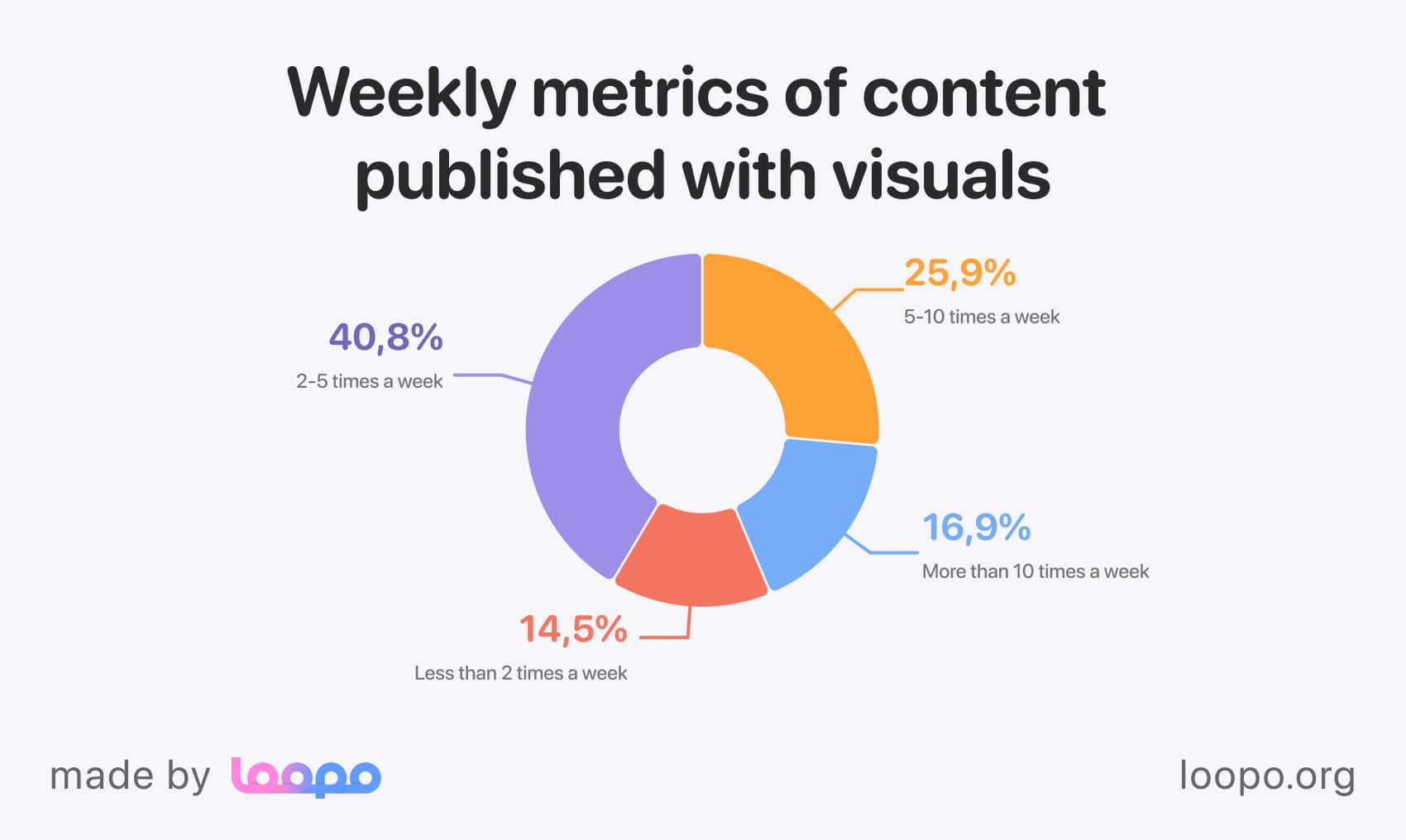
All kinds of visuals have great potential to be shared. They include images, videos, infographics, and GIFs that reflect your values, branding, style, etc. Moreover, whatever your startup focuses on, visual content can help convey complex information quickly and effectively.
Be authentic
In this matter, you can do a lot. For example, develop memorable and unique branding, design, and style for your website, social media, publications, and imagery. You can also show the human side of your startup. When focusing on authenticity, you will gradually build trust and foster genuine connections with your audience.
Content production cost: startup edition
Speaking of figuring out the actual cost for the entire content marketing strategy, it fluctuates a lot. Considering the idea that startups barely have a lot of funds for content marketing, you need to approach this matter wisely. Let’s start by dividing your future expenses into direct and indirect.
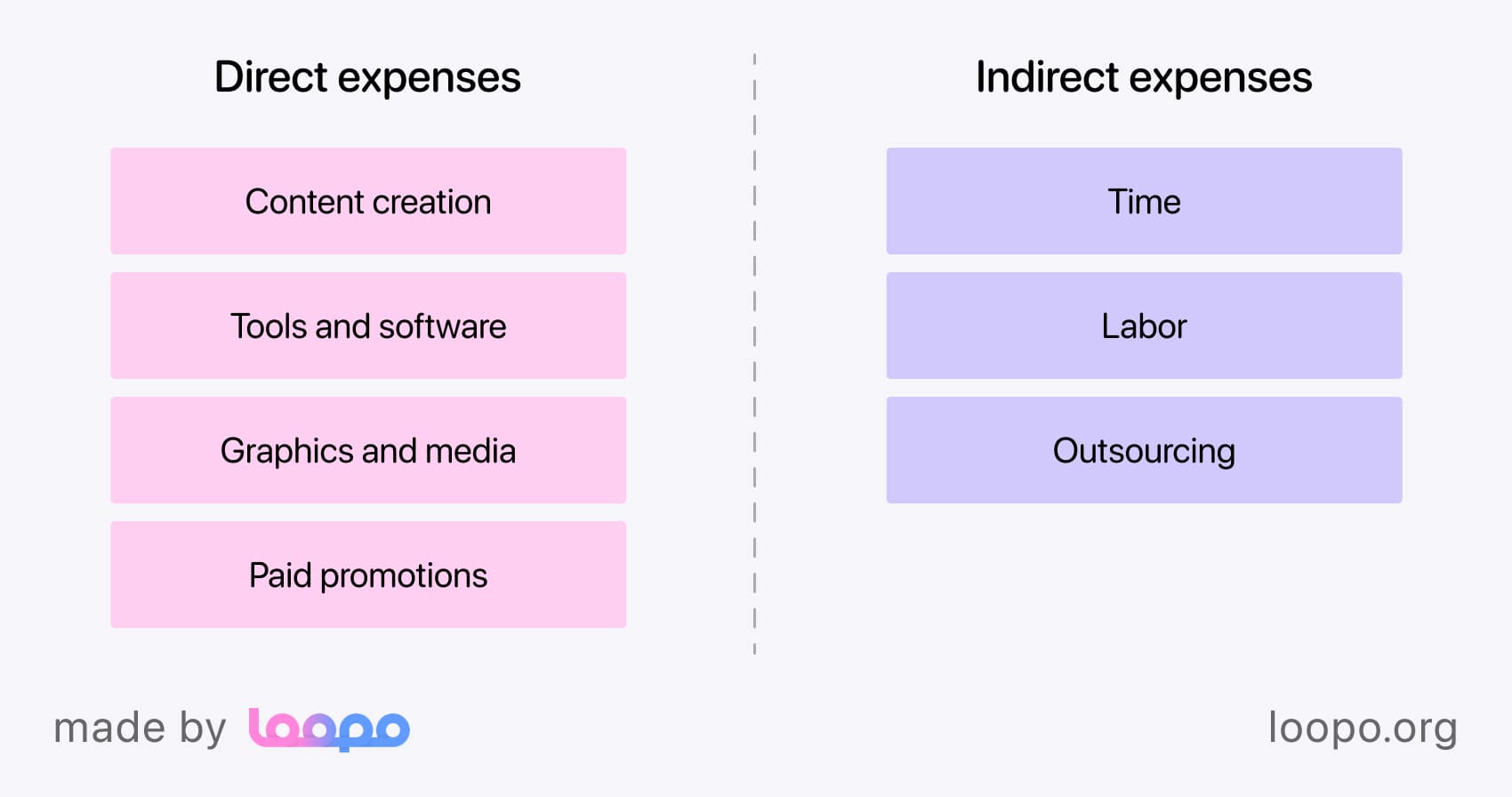
Direct expenses
- Content creation. This includes costs related to writing, design, photography, videography, and any other creative work required to develop the content itself.
- Tools and software. This encompasses all software, tools, and platforms you need to create content and edit it. It may also include tools for design, SEO optimization, and data analysis.
- Graphics and media. Costs for stock images, videos, icons, and other visual elements that enhance the quality of your content.
- Paid promotions. If you invest in paid advertising to promote your content on social media or search engines, these costs should be considered.
Indirect expenses
- Time. It may not be a direct monetary expense, the time invested by your team in content planning, creation, editing, and promotion carries an opportunity cost either on an hourly basis or on a fixed price.
- Labor. If you have in-house content creators, designers, or marketing professionals, their salaries contribute to the overall content production costs.
- Outsourcing. Every time you hire freelancers, agencies, or consultants to create or manage your content, these costs should be factored in.
Speaking of actual prices, they are difficult to predict, yet there are certain minimum and maximum prices you can rely on in your estimates.
| Content marketing aspect | Minimum monthly cost | Maximum monthly cost | Description |
| Content strategy | $300 | $3,000 | Creating a comprehensive plan outlining goals, target audience, content topics, and distribution channels. |
| Content creation | $400 | $2,000 | Cost for content creation (e.g., blog posts, articles, infographics, videos) depends on complexity and length. |
| Social media management | $300 | $1,500 | Cost for managing social media accounts, including content creation, scheduling, and community engagement. |
| Email marketing | $100 | $500 | Cost for designing and sending newsletters, promotional emails, and automated email campaigns. |
| Search engine optimization | $300 | $2,000 | Cost for optimizing website content, building backlinks, and improving search engine rankings. |
| Graphic design | $50 | $200 | Cost for creating visuals like custom images, infographics, banners, and other graphics for content marketing. |
| Video production | $500 | $5,000 | Cost for creating high-quality promotional or explainer videos, including scripting, shooting, and editing. |
| Content distribution | $100 | $2,000 | Cost for promoting content through paid ads, influencer partnerships, or content syndication platforms. |
| Analytics & reporting | $100 | $500 | Cost for tracking performance metrics and generating reports to measure the effectiveness of content marketing. |
| Total monthly cost | $2,150 | $16,700 | Range of total monthly costs for content marketing (sum of all aspects). |
After all, depending on the path you choose, the final cost can start from approximately $3,000 and rise up to $15,000 or even more.
Bottom line
In summary, on behalf of the entire Loopo team, we wish you luck in your endeavors. We are more than familiar with the difficulties modern startups face and are eager to help them. Hence, always remember to pay our pages a visit since we regularly focus on startup problems in our blog and social media.
Also, give Loopo a try, as it might be just the right tool to start managing your content marketing strategy. With or without it, we sincerely hope this article will have a significant impact on your future marketing affairs and spark inspiration to help you keep moving forward.





